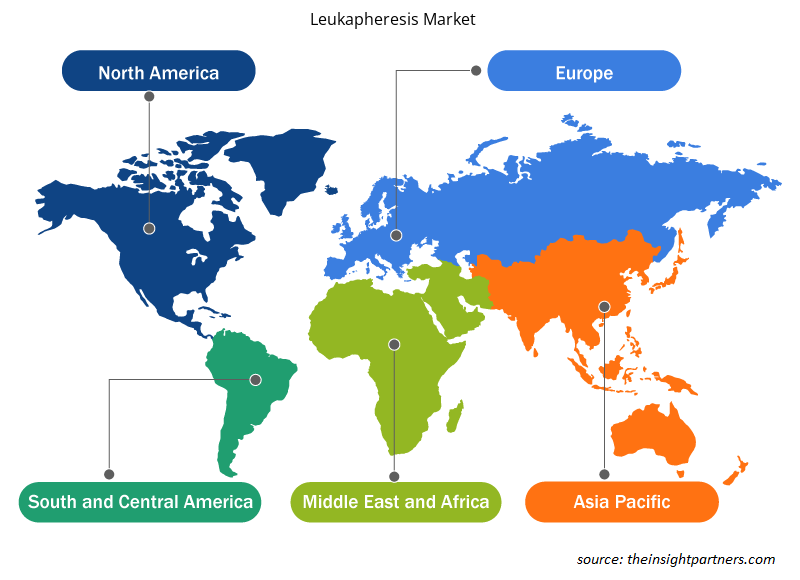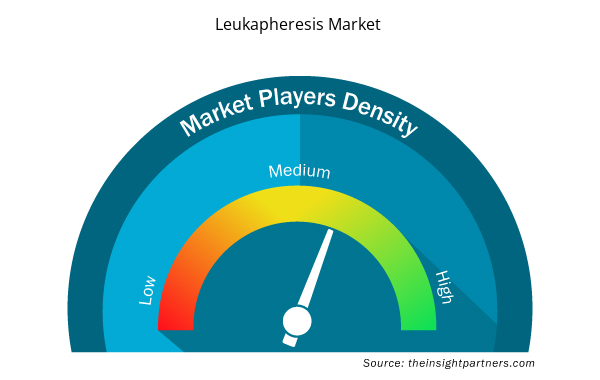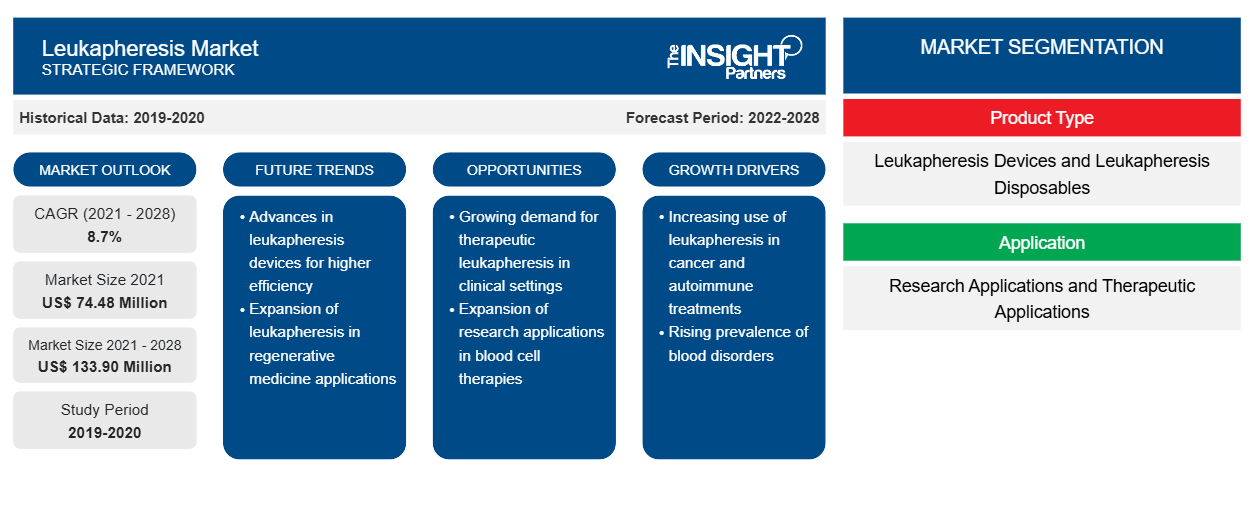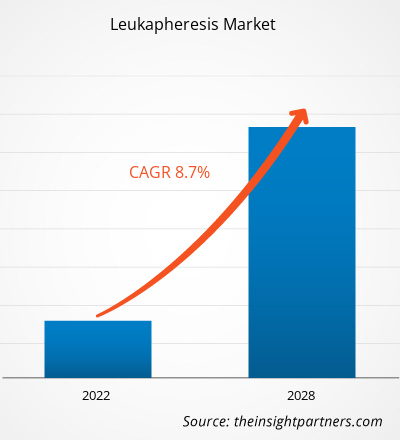[تقرير بحثي] من المتوقع أن يصل سوق فصل الكريات البيضاء إلى 133.90 مليون دولار أمريكي بحلول عام 2028 من 74.48 مليون دولار أمريكي في عام 2021؛ ومن المتوقع أن ينمو بمعدل نمو سنوي مركب قدره 8.7٪ من عام 2021 إلى عام 2028.
إن عملية فصل خلايا الدم البيضاء هي عملية يتم فيها فصل خلايا الدم البيضاء التي تشارك في الاستجابة المناعية للجسم عن عينة الدم. وهي شكل خاص من أشكال فصل خلايا الدم البيضاء حيث يتم الحصول على عنصر من الدم، مثل خلايا الدم الحمراء أو الصفائح الدموية، بينما يتم إعادة الدم المتبقي إلى الدورة الدموية. غالبًا ما يتم استخدام عملية فصل خلايا الدم البيضاء لتقليل عدد خلايا الدم البيضاء المرتفع جدًا، مثل سرطانات الدم المزمنة مثل سرطان الدم الليمفاوي المزمن. يمكن أيضًا إكمالها للحصول على خلايا الدم البيضاء لعمليات زرع لاحقة، مثل إدارة الانخفاضات المفاجئة في عدد خلايا الدم البيضاء أثناء العلاج الكيميائي للسرطان. استخدام آخر هو كجزء من شكل جديد من العلاج المناعي، يسمى علاج الخلايا التائية لمستقبلات المستضدات الكيمرية (CAR)، للمساعدة في مكافحة سرطان الدم وسرطان البروستاتا وأشكال أخرى من السرطان. يمكن إكمال عملية فصل خلايا الدم البيضاء على الشخص الذي يطالب بالعلاج (فصل خلايا الدم البيضاء الذاتي) أو على المتبرع لعملية زرع لاحقة (فصل خلايا الدم البيضاء الخيفي). في الوقت الحالي، تُستخدم تقنية فصل الكريات البيضاء بشكل شائع لعلاج العديد من الأمراض، كما تُستخدم أيضًا لأغراض التشخيص حيث يمكنها زيادة إنتاج الخلايا السرطانية المنتشرة. تعمل عوامل مثل العدد المتزايد من المتبرعين بالدم الطوعيين، وزيادة حالات الإصابة بأمراض الدم، وارتفاع عدد كبار السن على تغذية نمو سوق فصل الكريات البيضاء . ومع ذلك، فإن التكلفة العالية لتقنية فصل الكريات البيضاء تعيق نمو السوق إلى حد ما.
قم بتخصيص هذا التقرير ليناسب متطلباتك
ستحصل على تخصيص لأي تقرير - مجانًا - بما في ذلك أجزاء من هذا التقرير، أو تحليل على مستوى الدولة، وحزمة بيانات Excel، بالإضافة إلى الاستفادة من العروض والخصومات الرائعة للشركات الناشئة والجامعات
- احصل على أهم اتجاهات السوق الرئيسية لهذا التقرير.ستتضمن هذه العينة المجانية تحليلاً للبيانات، بدءًا من اتجاهات السوق وحتى التقديرات والتوقعات.
رؤى السوق
يعد نقل الدم جزءًا لا يتجزأ من البنية التحتية الصحية الوطنية وسياسات مختلف البلدان. وقد أدى التقدم في الصناعة الطبية إلى تحسينات في إجراءات علاج الأمراض والإصابات الخطيرة، مما دفع في النهاية إلى الحاجة إلى نقل الدم لبقاء المرضى على قيد الحياة. أدى الوعي المتزايد بأهمية نقل الدم وتوافر الدم في خدمات الرعاية الصحية إلى ارتفاع عدد الأشخاص الراغبين في التبرع بدمائهم لأسباب طبية. وفقًا لبيانات منظمة الصحة العالمية (WHO)، تم الإبلاغ عن حوالي 117.4 مليون تبرع بالدم في جميع أنحاء العالم في عام 2018. يتم تصنيف المتبرعين بالدم عادةً على أنهم طوعيون غير مدفوع الأجر، ومدفوعو الأجر، وأفراد الأسرة/البديل، ووفقًا لادعاءات منظمة الصحة العالمية، فإن المتبرعين الطوعيين/غير مدفوعي الأجر هم المصدر الرئيسي لإمدادات موثوقة وكافية من الدم. وفقًا لبيانات منظمة الصحة العالمية في عام 2019، زادت تبرعات الدم من قبل المتبرعين الطوعيين غير المدفوعي الأجر بمقدار 11.6 مليون من عام 2008 إلى عام 2015 في 139 دولة في العالم. كما اكتسب اتجاه التبرع بالدم أهمية كبيرة في البلدان ذات الدخل المنخفض والمتوسط. ووفقًا للبيانات المقدمة خلال الاجتماع السنوي لجمعية التبرع بالدم (CAG) لعام 2017، تم إجراء حوالي 13000 عملية جراحية على 1087 مريضًا في عام 2016. وقد لوحظت أكبر زيادة في عدد المتبرعين بالدم طوعيًا في دول جنوب شرق آسيا (83٪) والأمريكيتين (70٪).
إن البرامج الوطنية التي تم تطويرها وتنفيذها في العديد من البلدان تجتذب أعداداً كبيرة من المتبرعين بالصفائح الدموية والدم. على سبيل المثال، في الهند، يشكل المجلس الوطني لنقل الدم، الذي تم تشكيله داخل المنظمة الوطنية لمكافحة الإيدز، الهيئة المركزية التي تنسق مع مجالس نقل الدم في الولايات، التي أنشئت داخل جمعيات مكافحة الإيدز في الولايات. ويدعم المجلس الوطني لنقل الدم البرامج الصحية لمختلف الأنشطة المتعلقة بخدمات نقل الدم. وبالتالي، فإن العدد المتزايد من المتبرعين المؤهلين في مختلف البلدان في جميع أنحاء العالم يعزز الحاجة إلى معدات فصل الكريات البيضاء التي تستخدم لفصل مكونات الدم المطلوبة.
رؤى تعتمد على نوع المنتج
بناءً على نوع المنتج، ينقسم سوق فصل الكريات البيضاء إلى أجهزة فصل الكريات البيضاء وأدوات فصل الكريات البيضاء التي تُستعمل لمرة واحدة. في عام 2021، استحوذ قطاع أدوات فصل الكريات البيضاء التي تُستعمل لمرة واحدة على حصة سوقية أكبر. ومع ذلك، من المتوقع أن يسجل قطاع أجهزة فصل الكريات البيضاء معدل نمو سنوي مركب أعلى خلال الفترة من 2021 إلى 2028.
رؤى قائمة على التطبيق
ينقسم سوق فصل الكريات البيضاء، حسب التطبيق، إلىتطبيقات البحث والتطبيقات العلاجية. في عام 2021، استحوذ قطاع تطبيقات البحث على حصة أكبر من السوق ومن المتوقع أن يسجل نفس القطاع معدل نمو سنوي مركب أعلى خلال السنوات القادمة.
رؤى تعتمد على المستخدم النهائي
يتم تقسيم سوق فصل كريات الدم البيضاء، حسب المستخدم النهائي، إلى شركات الأدوية والتكنولوجيا الحيوية، والمؤسسات الأكاديمية والبحثية، ومقدمي مكونات الدم ومراكز الدم، والمستشفيات ومراكز نقل الدم. في عام 2021، احتلت شريحة مقدمي مكونات الدم ومراكز الدم الحصة الأكبر من السوق. من ناحية أخرى، من المتوقع أن تسجل شريحة المستشفيات ومراكز نقل الدم أعلى معدل نمو سنوي مركب خلال السنوات القادمة.
تتبنى الشركات العاملة في سوق فصل كريات الدم البيضاء استراتيجيات مثل إطلاق المنتجات، وعمليات الدمج والاستحواذ، والتعاون، وابتكار المنتجات، وتوسيع محفظة المنتجات لتوسيع بصمتها في جميع أنحاء العالم، والحفاظ على اسم العلامة التجارية، وتلبية الطلب المتزايد من المستخدمين النهائيين.
رؤى إقليمية حول سوق فصل الكريات البيضاء
لقد قام المحللون في Insight Partners بشرح الاتجاهات والعوامل الإقليمية المؤثرة على سوق فصل الكريات البيضاء طوال فترة التوقعات بشكل شامل. يناقش هذا القسم أيضًا قطاعات سوق فصل الكريات البيضاء والجغرافيا في جميع أنحاء أمريكا الشمالية وأوروبا ومنطقة آسيا والمحيط الهادئ والشرق الأوسط وأفريقيا وأمريكا الجنوبية والوسطى.

- احصل على البيانات الإقليمية المحددة لسوق فصل الكريات البيضاء
نطاق تقرير سوق فصل الكريات البيضاء
| سمة التقرير | تفاصيل |
|---|---|
| حجم السوق في عام 2021 | 74.48 مليون دولار أمريكي |
| حجم السوق بحلول عام 2028 | 133.90 مليون دولار أمريكي |
| معدل النمو السنوي المركب العالمي (2021 - 2028) | 8.7% |
| البيانات التاريخية | 2019-2020 |
| فترة التنبؤ | 2022-2028 |
| القطاعات المغطاة | حسب نوع المنتج
|
| المناطق والدول المغطاة | أمريكا الشمالية
|
| قادة السوق وملفات تعريف الشركات الرئيسية |
|
كثافة اللاعبين في سوق فصل الكريات البيضاء: فهم تأثيرها على ديناميكيات الأعمال
يشهد سوق فصل الكريات البيضاء نموًا سريعًا، مدفوعًا بالطلب المتزايد من المستخدم النهائي بسبب عوامل مثل تفضيلات المستهلكين المتطورة والتقدم التكنولوجي والوعي المتزايد بفوائد المنتج. ومع ارتفاع الطلب، تعمل الشركات على توسيع عروضها والابتكار لتلبية احتياجات المستهلكين والاستفادة من الاتجاهات الناشئة، مما يؤدي إلى زيادة نمو السوق.
تشير كثافة اللاعبين في السوق إلى توزيع الشركات أو المؤسسات العاملة في سوق أو صناعة معينة. وهي تشير إلى عدد المنافسين (اللاعبين في السوق) الموجودين في مساحة سوق معينة نسبة إلى حجمها أو قيمتها السوقية الإجمالية.
الشركات الرئيسية العاملة في سوق فصل الكريات البيضاء هي:
- شركة أساهي كاساي
- شركة فريسينيوس اس اي اند كو. كيه جي ايه
- شركة هيمونيتيك
- شركة تيرومو
- شركة ستيمسيل للتكنولوجيا
إخلاء المسؤولية : الشركات المذكورة أعلاه ليست مرتبة بأي ترتيب معين.

- احصل على نظرة عامة على أهم اللاعبين الرئيسيين في سوق فصل الكريات البيضاء
سوق فصل الكريات البيضاء – حسب نوع المنتج
- أجهزة فصل كريات الدم البيضاء
- أجهزة فصل الدم
- أعمدة فصل الكريات البيضاء وفصل الخلايا
- مرشحات تقليل الكريات البيض
- مواد فصل الكريات البيضاء القابلة للاستخدام مرة واحدة
سوق فصل الكريات البيضاء – حسب التطبيق
- تطبيقات البحث
- التطبيقات العلاجية
سوق فصل الكريات البيضاء – حسب المستخدم النهائي
- شركات الأدوية والتكنولوجيا الحيوية
- المؤسسات الأكاديمية والبحثية
- مقدمو مكونات الدم ومراكز الدم
- المستشفيات ومراكز نقل الدم
سوق فصل الكريات البيضاء – حسب الجغرافيا
أمريكا الشمالية
- نحن
- كندا
- المكسيك
أوروبا
- فرنسا
- ألمانيا
- إيطاليا
- المملكة المتحدة
- إسبانيا
- بقية أوروبا
آسيا والمحيط الهادئ (APAC)
- الصين
- الهند
- كوريا الجنوبية
- اليابان
- أستراليا
- بقية آسيا والمحيط الهادئ
الشرق الأوسط وأفريقيا
- جنوب أفريقيا
- المملكة العربية السعودية
- الامارات العربية المتحدة
- بقية الشرق الأوسط وأفريقيا
أمريكا الجنوبية (SAM)
- البرازيل
- الأرجنتين
- بقية أمريكا الجنوبية والوسطى
نبذة عن الشركة
- شركة أساهي كاساي
- شركة فريسينيوس اس اي اند كو. كيه جي ايه
- شركة هيمونيتيك
- شركة تيرومو
- شركة ستيمسيل للتكنولوجيا
- هيماكير
- ماكوفارما
- كل الخلايا
- ستيم اكسبريس
- بيو اي في تي
- التحليل التاريخي (سنتان)، السنة الأساسية، التوقعات (7 سنوات) مع معدل النمو السنوي المركب
- تحليل PEST و SWOT
- حجم السوق والقيمة / الحجم - عالميًا وإقليميًا وقطريًا
- الصناعة والمنافسة
- مجموعة بيانات Excel


- Drain Cleaning Equipment Market
- Analog-to-Digital Converter Market
- Electronic Signature Software Market
- Health Economics and Outcome Research (HEOR) Services Market
- Retinal Imaging Devices Market
- Nuclear Decommissioning Services Market
- Sleep Apnea Diagnostics Market
- Ceiling Fans Market
- Nuclear Waste Management System Market
- Bioremediation Technology and Services Market

Report Coverage
Revenue forecast, Company Analysis, Industry landscape, Growth factors, and Trends

Segment Covered
This text is related
to segments covered.

Regional Scope
North America, Europe, Asia Pacific, Middle East & Africa, South & Central America

Country Scope
This text is related
to country scope.
الأسئلة الشائعة
The leukapheresis market majorly consists of the players such Asahi Kasei Corporation, Fresenius SE & Co. KGaA, Haemonetics Corporation Terumo Corporation, STEMCELL Technologies Inc., HemaCare, Macopharma, AllCells, STEMEXPRESS, and BioIVT amongst others.
Global leukapheresis market is segmented by region into North America, Europe, Asia Pacific, Middle East & Africa, and South & Central America. In North America, the U.S. is the largest market for leukapheresis. The growth of the region is attributed to increasing product launches coupled with increasing patient population.
The Asia Pacific region is expected to account for the fastest growth in the leukapheresis market. Increase in government investments and a number of private biotechnology companies in this region contribute to this dominant share. The rising geriatric population and increasing investment in research are said to be responsible for this growth.
The leukapheresis disposables segment dominated the global leukapheresis market and held the largest revenue share of 61.43% in 2021.
The blood component providers and blood centers segment dominated the global leukapheresis market and accounted for the largest revenue share of 35.03% in 2021.
Key factors that are driving the growth of this market are number of voluntary blood donors, increasing incidence of hematologic diseases, surge in elderly population and growing demand for leukopaks in clinical research activities boost the market growth over the years.
Leukapheresis is a procedure that has white blood cells (leukocytes) involved in the body's immune response are segregated from a blood sample. It is a particular form of apheresis in which an element of blood, such as red blood cells or platelets, is obtained while the remaining blood is restored to circulation. Leukapheresis is often used to reduce very high white blood cell (WBC) counts, such as chronic blood cancers like chronic lymphocytic leukemia (CLL). It can also be completed to obtain white blood cells for later transplant, such as to manage abrupt declines in WBC counts throughout cancer chemotherapy. Another use is as a section of a novel form of immunotherapy, termed chimeric antigen receptor (CAR) T-cell therapy, to help fight leukemia, prostate cancer, and other forms of cancers. Leukapheresis can be completed on the person claiming treatment (autologous apheresis) or on a donor for a later transplant (allogeneic apheresis). Currently, leukapheresis is commonly used to treat various diseases, and it is also used for diagnostic purposes as it can increase circulating tumor cells yields.
Trends and growth analysis reports related to Life Sciences : READ MORE..
The List of Companies - Leukapheresis Market
- Asahi Kasei Corporation
- Fresenius SE & Co. KGaA
- Haemonetics Corporation
- Terumo Corporation
- STEMCELL Technologies Inc.
- HemaCare
- Macopharma
- AllCells
- STEMEXPRESS
- BioIVT
The Insight Partners performs research in 4 major stages: Data Collection & Secondary Research, Primary Research, Data Analysis and Data Triangulation & Final Review.
- Data Collection and Secondary Research:
As a market research and consulting firm operating from a decade, we have published and advised several client across the globe. First step for any study will start with an assessment of currently available data and insights from existing reports. Further, historical and current market information is collected from Investor Presentations, Annual Reports, SEC Filings, etc., and other information related to company’s performance and market positioning are gathered from Paid Databases (Factiva, Hoovers, and Reuters) and various other publications available in public domain.
Several associations trade associates, technical forums, institutes, societies and organization are accessed to gain technical as well as market related insights through their publications such as research papers, blogs and press releases related to the studies are referred to get cues about the market. Further, white papers, journals, magazines, and other news articles published in last 3 years are scrutinized and analyzed to understand the current market trends.
- Primary Research:
The primarily interview analysis comprise of data obtained from industry participants interview and answers to survey questions gathered by in-house primary team.
For primary research, interviews are conducted with industry experts/CEOs/Marketing Managers/VPs/Subject Matter Experts from both demand and supply side to get a 360-degree view of the market. The primary team conducts several interviews based on the complexity of the markets to understand the various market trends and dynamics which makes research more credible and precise.
A typical research interview fulfils the following functions:
- Provides first-hand information on the market size, market trends, growth trends, competitive landscape, and outlook
- Validates and strengthens in-house secondary research findings
- Develops the analysis team’s expertise and market understanding
Primary research involves email interactions and telephone interviews for each market, category, segment, and sub-segment across geographies. The participants who typically take part in such a process include, but are not limited to:
- Industry participants: VPs, business development managers, market intelligence managers and national sales managers
- Outside experts: Valuation experts, research analysts and key opinion leaders specializing in the electronics and semiconductor industry.
Below is the breakup of our primary respondents by company, designation, and region:

Once we receive the confirmation from primary research sources or primary respondents, we finalize the base year market estimation and forecast the data as per the macroeconomic and microeconomic factors assessed during data collection.
- Data Analysis:
Once data is validated through both secondary as well as primary respondents, we finalize the market estimations by hypothesis formulation and factor analysis at regional and country level.
- Macro-Economic Factor Analysis:
We analyse macroeconomic indicators such the gross domestic product (GDP), increase in the demand for goods and services across industries, technological advancement, regional economic growth, governmental policies, the influence of COVID-19, PEST analysis, and other aspects. This analysis aids in setting benchmarks for various nations/regions and approximating market splits. Additionally, the general trend of the aforementioned components aid in determining the market's development possibilities.
- Country Level Data:
Various factors that are especially aligned to the country are taken into account to determine the market size for a certain area and country, including the presence of vendors, such as headquarters and offices, the country's GDP, demand patterns, and industry growth. To comprehend the market dynamics for the nation, a number of growth variables, inhibitors, application areas, and current market trends are researched. The aforementioned elements aid in determining the country's overall market's growth potential.
- Company Profile:
The “Table of Contents” is formulated by listing and analyzing more than 25 - 30 companies operating in the market ecosystem across geographies. However, we profile only 10 companies as a standard practice in our syndicate reports. These 10 companies comprise leading, emerging, and regional players. Nonetheless, our analysis is not restricted to the 10 listed companies, we also analyze other companies present in the market to develop a holistic view and understand the prevailing trends. The “Company Profiles” section in the report covers key facts, business description, products & services, financial information, SWOT analysis, and key developments. The financial information presented is extracted from the annual reports and official documents of the publicly listed companies. Upon collecting the information for the sections of respective companies, we verify them via various primary sources and then compile the data in respective company profiles. The company level information helps us in deriving the base number as well as in forecasting the market size.
- Developing Base Number:
Aggregation of sales statistics (2020-2022) and macro-economic factor, and other secondary and primary research insights are utilized to arrive at base number and related market shares for 2022. The data gaps are identified in this step and relevant market data is analyzed, collected from paid primary interviews or databases. On finalizing the base year market size, forecasts are developed on the basis of macro-economic, industry and market growth factors and company level analysis.
- Data Triangulation and Final Review:
The market findings and base year market size calculations are validated from supply as well as demand side. Demand side validations are based on macro-economic factor analysis and benchmarks for respective regions and countries. In case of supply side validations, revenues of major companies are estimated (in case not available) based on industry benchmark, approximate number of employees, product portfolio, and primary interviews revenues are gathered. Further revenue from target product/service segment is assessed to avoid overshooting of market statistics. In case of heavy deviations between supply and demand side values, all thes steps are repeated to achieve synchronization.
We follow an iterative model, wherein we share our research findings with Subject Matter Experts (SME’s) and Key Opinion Leaders (KOLs) until consensus view of the market is not formulated – this model negates any drastic deviation in the opinions of experts. Only validated and universally acceptable research findings are quoted in our reports.
We have important check points that we use to validate our research findings – which we call – data triangulation, where we validate the information, we generate from secondary sources with primary interviews and then we re-validate with our internal data bases and Subject matter experts. This comprehensive model enables us to deliver high quality, reliable data in shortest possible time.


 احصل على عينة مجانية لهذا التقرير
احصل على عينة مجانية لهذا التقرير